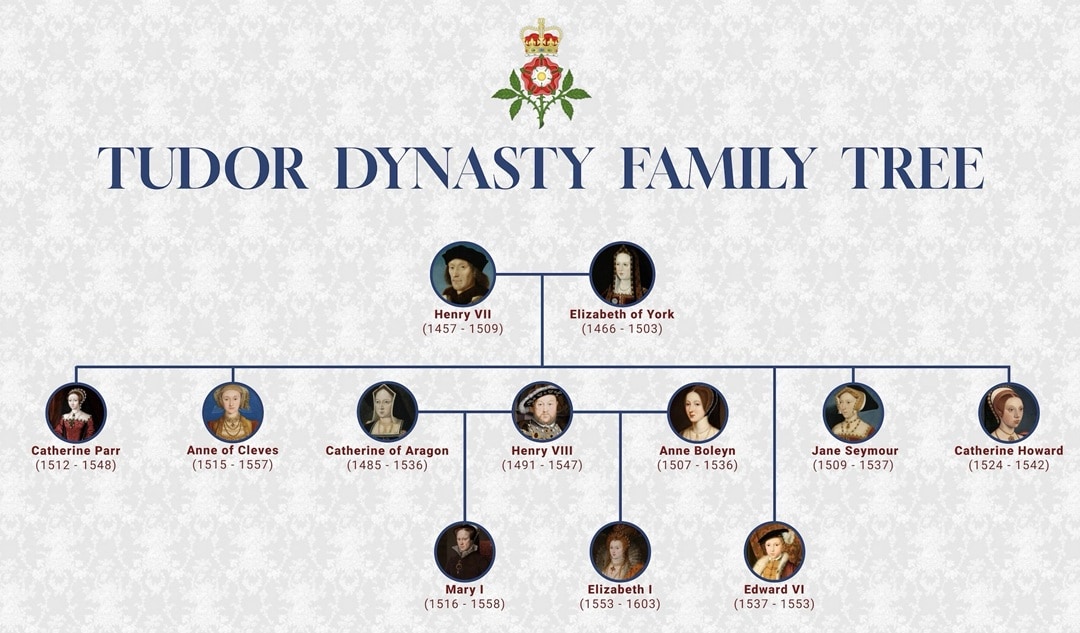The Tudor family tree defines English history through its 118-year reign, marked by drama, religious turmoil, and powerful monarchs.
These kings and queens left a lasting impact on England. Their story is complex and fascinating. If you want to understand more about their reigns, then keep reading.
This article guides you through the key figures of the Tudor family tree and explains how their legacy transformed England. You’ll also learn how to create a family tree using EdrawMax.
In this article
The Tudor Family Tree
The dynasty's story spans five monarchs. It is a tale of ambition, religion, and the desperate need for an heir.
The Rise of Henry VII and Elizabeth of York
The Tudor dynasty began with a brutal conflict. The Wars of the Roses pitted two royal houses against each other. The House of Lancaster (red rose) fought the House of York (white rose) for the English throne.
Henry Tudor, a Lancastrian claimant, ended the war in 1485. This victory made him King Henry VII.
Henry VII needed to secure his claim, and so he made a brilliant political move: he married Elizabeth of York. She was the eldest daughter of King Edward IV of the Yorkist dynasty.
Their marriage united the warring houses, which symbolized peace.
The new Tudor Rose emblem combined the red and white roses. This union was successful and founded a powerful new dynasty.
Henry VII proved to be a shrewd and careful king. He stabilized England's finances and strengthened the monarchy. To secure the new Tudor dynasty, he and Elizabeth also had several children.
Their eldest son, Arthur, was the heir. Arthur married Catherine of Aragon, but died shortly after. This event set the stage for future problems. Their second son, Henry, would later become the kingdom's most famous king.
The King of Six Wives: Henry VIII's Marriages
Henry VIII is the dynasty's most notorious figure. When he inherited the kingdom from his father in 1509, he first married Catherine of Aragon, the widow of his older brother.
Together, they had only one surviving child, a daughter named Mary.
Henry VIII desperately wanted a male heir. He believed the lack of a son was a divine punishment, so he sought an annulment from the Pope.
The Pope refused.
Henry's desire for a new wife, Anne Boleyn, fueled his next move. He broke with the Roman Catholic Church. He declared himself the head of the new Church of England. This act was the English Reformation.
It changed English religion and society forever.
Henry married Anne Boleyn in 1533. She gave him another daughter, Elizabeth. Henry grew disillusioned. He accused Anne of treason and had her executed.
His third wife, Jane Seymour, finally gave him a son, Edward. Jane died days after giving birth.
Henry's quest continued, first with a purely political marriage to Anne of Cleves. But this, too, did not last long since he found her unattractive and divorced her almost immediately.
Following this impersonal political failure, Henry next married the young Catherine Howard, likely seeking passion. This, too, ended in tragedy when he accused her of adultery and had her executed.
After the trauma of his fifth marriage, Henry's final wife, Catherine Parr, provided a much-needed period of stability. She was a kind stepmother to his three children and outlived the king.
The Heirs to the Throne
When Henry VIII died in 1547, the throne passed to his nine-year-old son, Edward VI. Being too young to govern, his regents used their power to push radical Protestant reforms across England.
This period of reform was brief, as Edward was a sickly child who died at 15.
He attempted to exclude his Catholic half-sister, Mary, from the succession, naming his Protestant cousin, Lady Jane Grey, as his heir instead.
But this decision did not hold.
Lady Jane Grey ruled for only nine days before Mary rallied support and claimed her rightful throne.
Queen Mary I was England's first undisputed queen regnant. She was a devout Catholic like her mother, Catherine of Aragon. Mary tried to reverse the English Reformation.
She wanted to restore Catholicism. Mary's persecution of Protestants earned her the grim nickname "Bloody Mary." She died childless in 1558.
Queen Mary I was England's first undisputed queen regnant. Because she was a Catholic like her mother, Catherine of Aragon, her primary goal was to reverse the English Reformation and restore Catholicism.
This effort to undo her father's work involved the fierce persecution of Protestants, which earned her the grim nickname 'Bloody Mary.' However, her Catholic restoration failed, as she died childless in 1558.
The Golden Age: The Era of Elizabeth I
Mary's death brought her half-sister, Elizabeth, to the throne.
Elizabeth I became one of England's greatest monarchs, reigning for 45 years. A key reason for her success was her intelligence and political skill. Using these abilities, she navigated a dangerous political landscape.
A prime example of this skill was the Elizabethan Religious Settlement, a compromise between Protestant and Catholic practices that finally brought relative religious stability to England.
Elizabeth never married.
Her greatest military victory was the defeat of the Spanish Armada in 1588. This naval triumph secured England's independence. Elizabeth I died in 1603. She had no heir. Her death ended the Tudor dynasty.
The throne passed to her cousin, James VI of Scotland. He became James I of England, marking the beginning of the Stuart line.
How To Make a Family Tree in EdrawMax
Family trees help you visualize complex relationships like the Tudors’. If you want to create a family tree, a powerful tool for this task is Wondershare EdrawMax, an all-in-one, user-friendly diagramming solution.
You can use it to design over 210 types of diagrams for project management, research, design, and remote work. These include family trees, organizational charts, flowcharts, floor plans, and much more. EdrawMax is well-suited for both personal and professional projects.
Key Features
It offers many powerful features:
- Predesigned Template Library: Access over 23,000 user-made templates for 210 diagram types.
- Extensive Symbols: Use 26,000 free, built-in symbols to customize your charts and diagrams.
- 36 AI Tools: Use them to analyze diagrams, convert text to charts, generate images, create symbols, and more.
- Versatile Exporting: Export diagrams in 13 file formats, including MS Office, images, and VSDX.
You can use EdrawMax to organize historical family trees or personal genealogy projects easily. Here’s a simple guide to creating a family tree.
Step1 Open EdrawMax
After installing the app, open it and sign in to your account.
- Click New in the top left corner to start from scratch. Then choose Blank Drawing.
- Go to Templates on the left side navigation pane. Enter a keyword in the search bar to look for a family tree template.
- Go to Edraw AI in the left-side navigation pane. Then, enter a description, and the AI tool will generate a suitable diagram for you.

Step2 Add Shapes to Canvas
- Enter "family tree" in the Symbols search bar from the left panel.
- Scroll down and drag and drop your chosen symbols into the editing canvas.
- Position the shapes to map out the family lineage.

Go to Shape > Line Tool in the upper navigation menu to add arrows or lines. Copy, paste, and resize the arrows to connect the family members.

Step3 Add Pictures and Details
- Select a shape on your canvas.
- Go to Insert > Picture > Local pictures from the top menu.
- Drag a photo of the family member to the selected shape.
- Add text, such as names and dates.

Step4 Customize the Family Tree
- Select any shape from the canvas, then open the right panel and go to the Line tab. Customize the Color, Line Weight, or add shadows.
- Choose a line that connects two shapes. Use the floating toolbar to change the Line Color, Line Type, and Line Weight.
- Go to the Design tab in the top menu. You can add a background color for the entire family tree.

Step5 Export Your Finished Diagram
- Go to File > Export to Other Formats.
- Choose your desired format. You can export the file as a PDF, image, PPT, Excel, or other types.
Conclusion
The Tudor family tree produced some of England's most formidable rulers. The line began with Henry VII, a king who won his crown in battle, and ended with the brilliant Elizabeth I.
Their legacy of religious revolution and cultural flourishing defines the era. Seeing this lineage in a family tree diagram helps untangle the events in history.
If you’re fascinated by their legacy, you can map it visually using EdrawMax. Its AI tools and template library allow anyone to visualize even intricate dynasties, such as the Tudors, in minutes.





